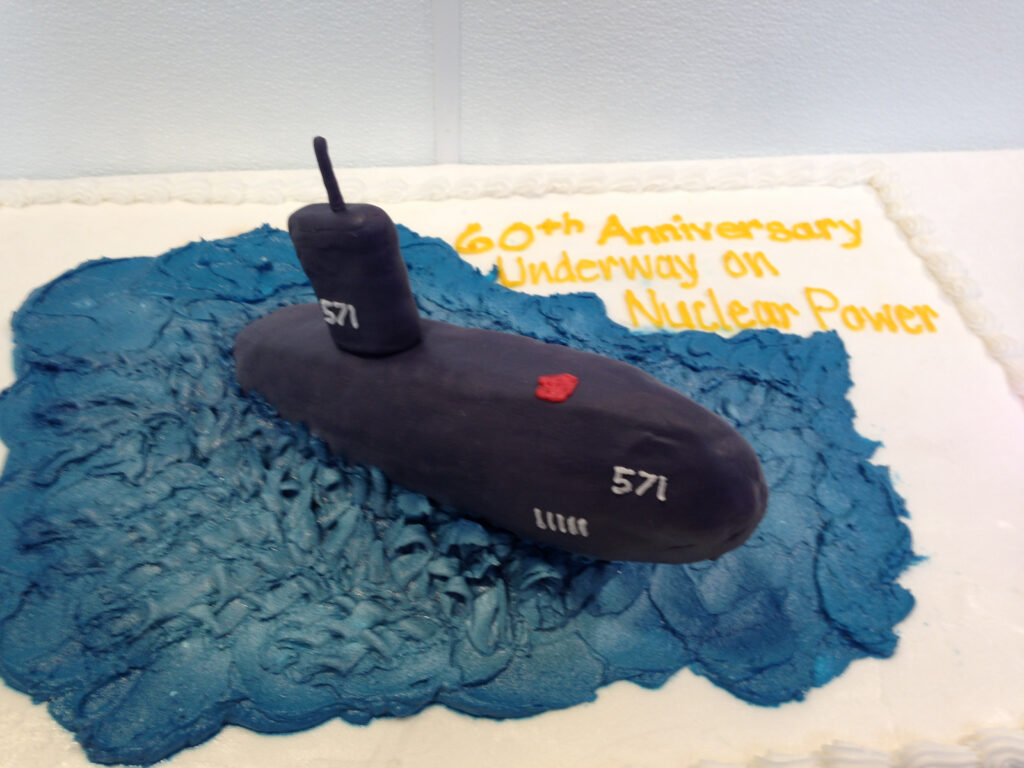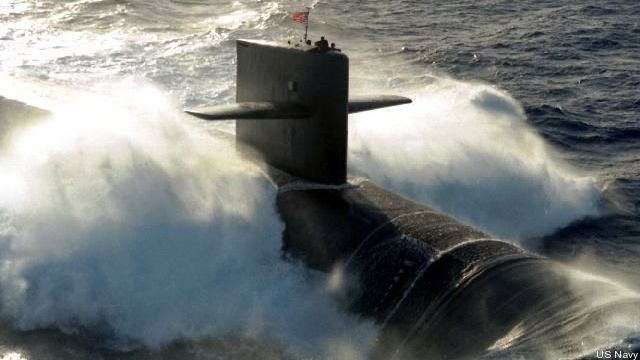
WASHINGTON NAVY YARD: One of the most secretive agencies in the Navy didn’t just invite reporters to its headquarters today: It offered them cookies and cake.

Adm. Rickover’s widow Eleonore at today’s ceremony
The agency? The Navy Nuclear Propulsion Program. The occasion? The 60th anniversary of the first submarine ever to sail under nuclear power. But there’s a lot more going on at “Naval Reactors” than nostalgia, an edible USS Nautilus, and affectionate jokes about the late Admiral Hyman Rickover, the notoriously tough founder of NR in whose honor the Navy is naming its next sub. As soon as the celebration’s done, Rickover’s heirs have to get right back to work on the design that will carry the force through the next 60 years: the Ohio Replacement.
At an estimated $95 billion for 10 ballistic missile submarines (SSBNs), the program faces daunting technological, schedule, and fiscal challenges. So what’s foremost on the mind of NR’s director, Adm. John Richardson?
“You’ve heard a couple of people mention today the ’40-year core,'” Richardson told reporters as the festivities wound down. The current Ohio subs and the nuclear Nimitz aircraft carriers require an expensive, lengthy mid-life overhaul to replace their reactor cores after 15 to 25 years of service. The new Virginia attack subs have cores designed to last the life of the sub, 33 years, although none of them is that old yet. The Ohio Replacement reactor core is supposed to last an unprecedented four decades.
“That has tremendous implications,” said Adm. Richardson, “about a $40 billion saving over the life of the program…but that’s by no means a done deal.”

Adm. John Richardson
Bypassing the multi-year mid-life overhaul means each submarine can spend more of its service life at sea, instead of in the shipyard. The Navy calculates the 40-year-core will allow 12 Ohio Replacement submarines to do the work of the current 14 Ohios. It will also save on maintenance funds, spare parts, and more. But it’s also making a huge bet on the core’s reliability.
“You’re talking about putting something into a reactor plant and leaving it there for 40 years at high pressure, high temperature, [and] radiation flux — all the things that come with nuclear power,” Richardson said. “Doing that safely and reliably [is] not a trivial matter. So each step, each move along that path, takes a tremendous amount of attention to detail.”
Richardson is also responsible for the parts of the propulsion system that aren’t radioactive. In the Ohio Replacement’s case, that includes an electric drive almost as unprecedented as the 40-year-core. Almost all naval vessels have an engine that connects directly to the propellers via a mechanical driveshaft: The sole exception so far is the destroyer USS Zumwalt, whose generator sends power to electric motors behind each propeller instead. That’s called electric drive, and the Ohio Replacement will be the first submarine to use it.
“This submarine’s going to have electric drive; there’s some engineering that we have to step through to de-risk that,” Richardson said.
This year will see “really important work in those two areas” (drive and core), Richardson summed up. There’s not much time. To get a sub this complicated on patrol in 2031, when the Ohios start wearing out, construction must begin in 2021. “Very soon,” said Richardson, “we’re going to be buying components and cutting contracts, before you know it.”
That brings us to the question that’s bedeviled the Ohio Replacement Program: how to pay for it? The Navy itself has officially acknowledged its current shipbuilding plans are “unsustainable” unless it gets dedicated funding for ORP.
“We’re going to fund the Ohio Replacement; that is not in the balance,” Sean Stackley, assistant secretary of the Navy for research, development, and acquisition, said earlier this week at the Atlantic Council. Nuclear missile submarines are essential to the nation’s nuclear deterrent, and even disarmament-minded Obama will not give that up. So the real question, Stackley said, is what else suffers to pay for the Ohio Replacement Program?

Navy Secretary Ray Mabus
“This is obviously one of our nation’s — not just Navy’s, but nation’s – – highest priorities,” Navy Secretary Ray Mabus told reporters after today’s 60th anniversary celebration. “It’s the most survivable leg of the nuclear triad.”
“Our argument has been this is a national program; it should be funded in some different way so we don’t gut the Navy to fund this program,” Mabus continued. The last time the Navy built nuclear missile subs, the current Ohio class, its shipbuilding budget was much higher; this time, Congress has created a special fund outside the regular Navy budget — although there’s no money actually in that fund just yet.
“I don’t think you pay for one type of ship with another type of ship,” Mabus said. “You’ve got to look other places. I’m going to protect ship building and aircraft production because we’ve got to have that for our presence [around the world]. But if bad things happen, if sequester hits again or things like that, it’s going to have a major, major devastating impact somewhere. It may not be in shipbuilding. But you can’t take that big a bit without something happening.”

An Ohio-class nuclear ballistic missile submarine
Major trends and takeaways from the Defense Department’s Unfunded Priority Lists
Mark Cancian and Chris Park of CSIS break down what is in this year’s unfunded priority lists and what they say about the state of the US military.


























